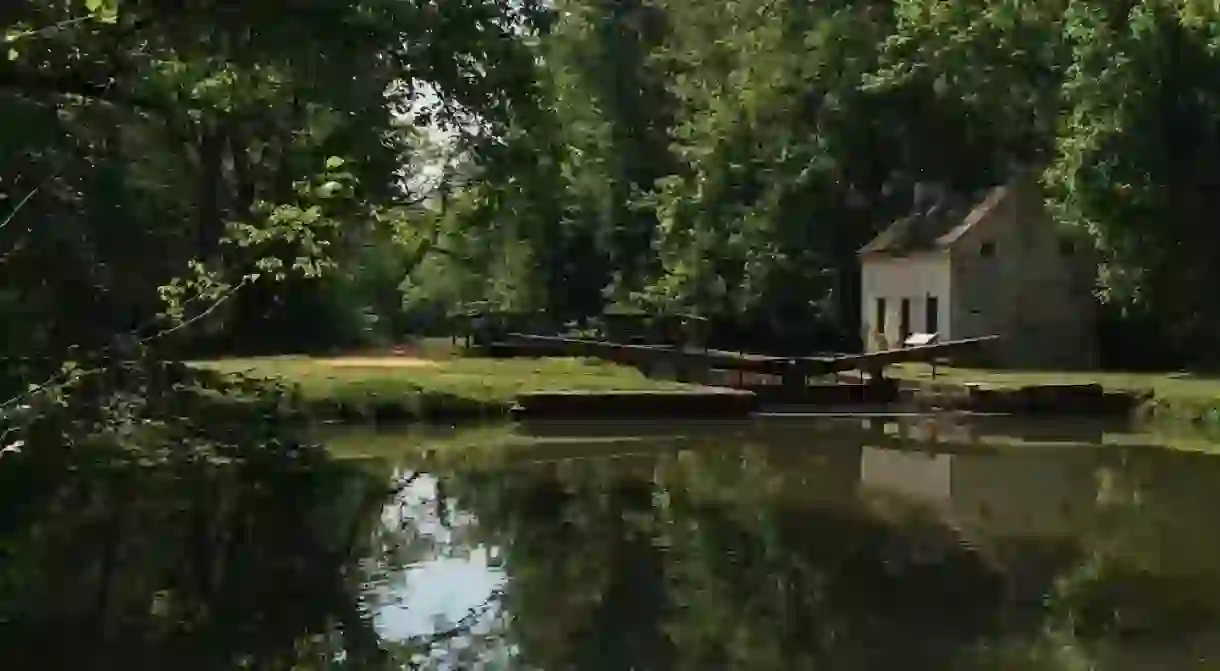6 D.C.-Area C&O Canal Lockhouses to Stay in Overnight

Running the length of the C&O Canal from Georgetown, D.C. to Cumberland, Maryland, these former quarters for lockkeepers and their families sleep up to eight—perfect for hikers, history buffs, nature-loving families, and introverts’ retreats.
As a young surveyor, George Washington dreamt of a Potomac River water route expanding westward from Fairfax, Virginia, into the Ohio Valley. In subsequent years, between presidential duties, he established the Patowmack Company, which in 1802 opened the Potomac River to boat travel.
Obstacles kept this system from operating continuously; nevertheless, a version of Washington’s dream manifested after his death. In 1828, the Chesapeake and Ohio Company began construction of a stillwater canal alongside the Potomac.
The C&O Canal was completed in 1850, already overshadowed by the railroad, and it stopped in Cumberland, Maryland—not Pittsburgh, as Washington imagined. Still, for almost 75 years, the canal carried coal, lumber and wheat between markets, providing jobs and energizing communities along its path.
A flood destroyed the canal in 1924, but people continued to live in its cabins until 1971 when the C&O Canal National Historical Park was established. The C&O Canal Trust, which partnered with this National Park, began renovating the lockhouses in 2009. Today, each Canal Quarters Lockhouse offers a window into a different period of the Canal’s history.
Lockhouse 6
Cabin

The Potomac riverside that inspired Washington’s dreams is steps from Lockhouse 6. Guests can also hop on their bikes and ride to Georgetown’s restaurants along the Capital Crescent Trail. Such recreational land use fulfills the vision of another dreamer from the C&O Canal’s past, Justice William O. Douglas. In 1954, Douglas hiked the canal’s entire 185-mile (297-kilometer) length to raise awareness of its environmental and historical value to all. Lockhouse 6 is furnished in a 1950s style to honor this early conservationist and features modern amenities, including electricity.
Lockhouse 10
Cabin

Like Lockhouse 6, Lockhouse 10 is close to D.C.’s cultural attractions and features modern amenities while affording easy access to hiking, fishing and canoeing. The house tells the story of work, not play, however. According to The Canal Trust, during the Roosevelt Administration, two Civilian Conservation Corps (CCC) camps comprised of African Americans were established near Carderock, MD, two miles (3.2 kilometers) upstream from Lockhouse 10. Today The Canal Trust is looking for personal stories of these workers and their descendants to deepen their interpretive message of this post-Depression era when African Americans played a major role in the development and folkways of the Washington region.
Lockhouse 22
Cabin

With no electricity, Lockhouse 22 feels more rustic than the canal quarters closer to D.C. Visitors can play by the Potomac River, walk three miles (4.8 kilometers) downstream to Great Falls, and generally relax off the grid—as if camping, but no tent required. This is also a good stopping point for those biking from Georgetown to Harper’s Ferry and provides a home base from which to explore the architectural features of the early canal era. Lockhouse 22, which has a lift lock and is close to Dam 2, is furnished to reflect the 1830s and ’40s, a time when stone cutters and masons built lift locks, lift bridges, and dams to navigate obstacles on the C&O Canal.
Lockhouse 25
Cabin

Lockhouse 25 appeals to history-minded storytellers and ghost-seekers. In 1861, when Virginia seceded from the Union, the formerly quiet town of Edwards Ferry suddenly militarized. Confederate soldiers attacked the boats on the C&O Canal ferrying goods between Loudon County and Georgetown. Union soldiers occupied local farms in efforts to protect the canal. Lockhouse 25 guests can access haunting ruins like Jarboe’s Store and historic sites like Ball’s Bluff to imagine dramas past. Canal Quarters 25, like Lockhouse 22, is not for the high maintenance crowd; it sports a porta-potty “outhouse” and darkish interior.
Lockhouse 28
Cabin
Also one of the remote Canal Quarters, this lockhouse sits along the Potomac at the site of a former intense competition between the C&O Canal and the Baltimore & Ohio Railroad. Between 1828 and 1832, both projects fought to cut through a mountain ridge at Point of Rocks, MD. The Canal initially won this court battle, but when flooding shut it down for good, the big win went to the railroad, still active today. At Lockhouse 28, guests may enjoy a peaceful day by the river, or hike from their rustic sleeping quarters to nearby Harper’s Ferry—a popular destination for its history, culture, dining and trails.
Lockhouse 49
Cabin

Canal Quarters Lockhouse 49 echoes with the history of Four Locks, a former boomtown, named after four C&O Canal locks built within a quarter-mile space. In the early 1920s (the time period reflected in this canal quarter’s furnishings), Four Locks buzzed with merchants, laborers, and families all working together in a tight-knit community. Boomtown turned to ghost town when the canal closed, but visitors today can still enjoy boating, fishing, or horseback riding. Also, Fort Frederick State Park is a short hike away. This lockhouse offers electricity, but no indoor water or plumbing.













